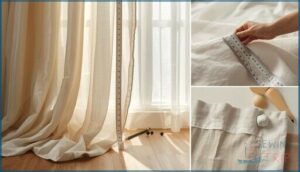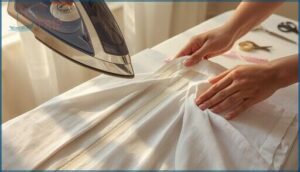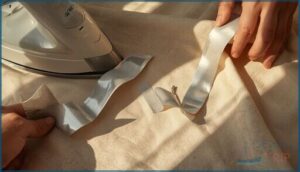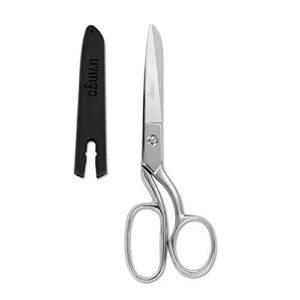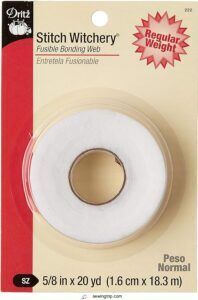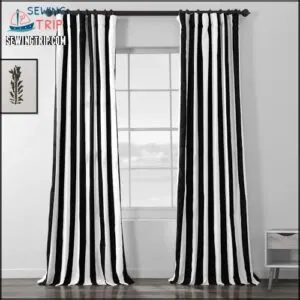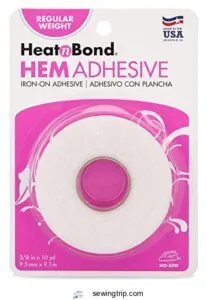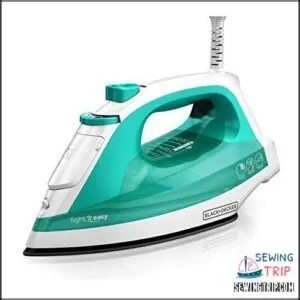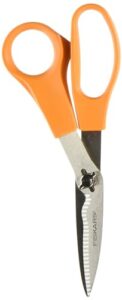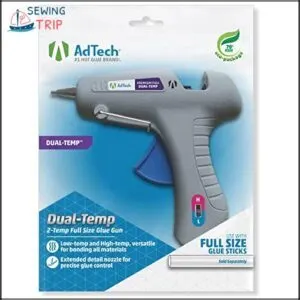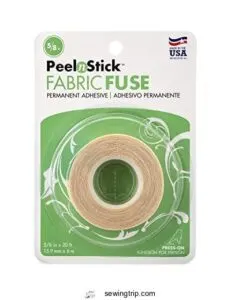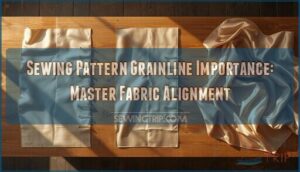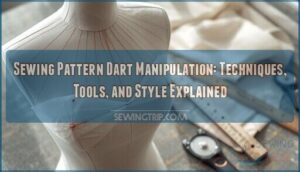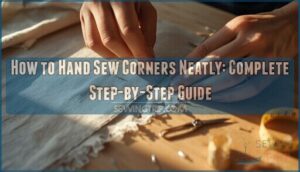This site is supported by our readers. We may earn a commission, at no cost to you, if you purchase through links.
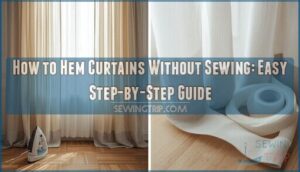
You’ve just scored the perfect curtains, but they’re pooling on the floor like fabric waterfalls. Before you dig out that dusty sewing machine or pay a tailor, there’s a faster route. No-sew hemming transforms those too-long panels into polished window treatments in under an hour—no needles, no thread, no frustration.
Whether you’re renting and can’t commit to permanent alterations or simply want results today instead of next week, adhesive hem tapes deliver professional-looking hems that hold up through months of use. With the right tape and a few simple techniques, you’ll have custom-length curtains hanging beautifully before dinner.
Table Of Contents
- Key Takeaways
- Why Hem Curtains Without Sewing
- Choosing The Right No-Sew Hem Tape
- Measuring Curtains for a Perfect Hem
- Preparing Curtains for No-Sew Hemming
- Iron-on Hem Tape Hemming Method
- Peel and Stick Hem Tape Hemming Method
- Top 9 Products for No-Sew Curtain Hemming
- 1. Livingo Heavy Duty Tailor Scissors
- 2. Stitch Witchery Fusible Bonding Web White
- 3. Black and White Striped Curtains
- 4. HeatnBond Hem Iron On Adhesive
- 5. Black and Decker Light ‘N Easy Iron
- 6. Colorful Ball Glass Head Sewing Pins
- 7. Fiskars Take Apart Kitchen Shears
- 8. AdTech 2 Temp Hot Glue Gun
- 9. HeatnBond PeelnStick Fabric Fuse Adhesive
- Tips and Troubleshooting No-Sew Curtain Hems
- Frequently Asked Questions (FAQs)
- Conclusion
Key Takeaways
- You can hem curtains in under an hour using iron-on hem tape or peel-and-stick adhesive strips—no sewing machine, thread, or special skills required, just heat or pressure to create clean, washable hems.
- Choosing the right hem tape matters: lightweight fabrics need thin adhesive strips, heavy blackout curtains require heavy-duty options, and always check if your tape can handle machine washing if you plan to launder your panels regularly.
- Accurate measuring makes the difference between professional-looking curtains and a messy project—measure at three spots across each panel, add 6-8 inches for the hem fold, and press your fabric completely flat before applying any adhesive.
- No-sew methods save you time and money while giving you the flexibility to adjust curtain lengths later, making them perfect for renters, quick room makeovers, or anyone who wants custom-fit window treatments without the learning curve of traditional sewing.
Why Hem Curtains Without Sewing
You don’t need a sewing machine to get your curtains looking perfect. No-sew hemming methods save you time, money, and a whole lot of frustration.
Let’s explore why these techniques work so well, who benefits most from them, and when they’re your best option.
Advantages of No-sew Hemming Methods
No-sew methods like iron-on tape and fabric adhesive techniques deliver real time efficiency—you’ll finish in 20–40 minutes instead of over an hour with a sewing machine. Cost savings add up fast since you won’t buy equipment or thread.
Adjustability shines if you move homes, and the aesthetic outcomes? Surprisingly clean, flat hems that rival traditional sewing. It’s the quintessential sewing alternative for quick, beautiful results.
Who Should Use No-sew Techniques
No-sew methods work beautifully if you face sewing skill limitations or live as a renter needing adaptability. Time-saving households love these nosew method shortcuts, while style experimenters refresh spaces frequently without committing to permanent stitches.
Beginner hobbyists gain confidence tackling DIY projects with sewing alternatives that feel approachable. If you’re anyone craving freedom from machines—or just a quick win—No Sew Projects deliver mastery without the learning curve.
Common Situations for No-sew Curtain Hemming
Now that you’ve found your place among the no-sew crowd, when might you actually need this technique? Rental restrictions often prevent permanent alterations, making hem tape your best friend. Ready-made lengths rarely match your windows perfectly, while event staging demands quick fixes. Style changes become simple when you’re free to adjust without equipment. These no-sew method scenarios transform intimidating curtain projects into victories you can celebrate today.
Choosing The Right No-Sew Hem Tape
Not all hem tapes are created equal, and picking the right one can make or break your curtain project. You’ll find a few different types on the market, each with its own strengths and quirks.
Let’s walk through what you need to know so you can choose the best tape for your curtains.
Types of Hem Tapes for Curtains
When you’re choosing the right hem tape, you’ll encounter several types designed for different curtain projects. Iron-on hem tape, also called fusible webbing, uses heat to create a permanent bond. Adhesive tapes give you peel-and-stick convenience without an iron. Heavy-duty tapes work best for thick blackout panels, while lighter options suit sheer fabrics beautifully. Temporary tapes let you adjust later if needed.
Here are the main types you’ll find:
- Fusible iron-on tapes – heat-activated adhesive that bonds at 120–150°C
- Peel-and-stick fabric adhesive – double-sided tape requiring no heat
- Super-weight heavy-duty tapes – designed for thick drapery and blackout curtains
- Lightweight adhesives – narrow fusible webbing perfect for sheer fabrics
- Temporary hem tapes – removable options for adjustable curtain lengths
Factors to Consider When Selecting Hem Tape
Before you grab any hem tape off the shelf, think about your curtain’s fabric weight—lightweight panels under 150 GSM need lighter adhesive tape, while heavy blackout curtains above 250 GSM demand heavy-duty iron-on hem tape.
Check fiber content too, since polyester requires special fabric adhesive formulas.
Tape width, heat activation settings, and your curtains’ use conditions all matter for lasting results!
Washability and Permanence of Adhesive Options
When you’re planning to wash your curtains regularly, you need to understand how different adhesive options hold up over time. Here’s what affects durability:
- Iron-on hem tape maintains 70-80% adhesion after standard wash cycles and performs best on stable woven fabrics like cotton and polyester—making it a strong sewn hems comparison for permanent results.
- Peel-and-stick fabric fuse works great for quick projects but shows earlier edge lifting under high-agitation cycles, especially on heavier curtain fabrics.
- Laundering best practices matter most—cool water, gentle cycles, and low-heat drying protect adhesive bond strength far better than hot, aggressive washing.
The fabric type effect is huge! Lightweight cotton curtains place less stress on no-sew methods than dense blackout panels. For best results with any fabric adhesive techniques, wait 24 hours before the first wash cycle impact test—premature laundering greatly increases hem separation risk.
Measuring Curtains for a Perfect Hem
Getting the measurements right is where the magic happens—it’s the difference between curtains that just hang there and curtains that look professionally finished. You’ll need to figure out your ideal length, mark it accurately, and plan for that extra fabric fold that creates a clean hem.
Let’s walk through each step so your curtains end up exactly where you want them.
Determining The Ideal Curtain Length
Your curtain length isn’t just about covering glass—it transforms how spacious your room feels. Standard lengths like 84, 96, or 108 inches work for most homes, but ceiling height and room function matter too. Aim for about half an inch of floor clearance to avoid dragging, or let them puddle slightly for drama. Visual proportion depends on balancing measurements with your style goals.
| Style Choice | Floor Clearance |
|---|---|
| Float length | 0.25–1 inch above |
| Floor-grazing | Just touches floor |
| Puddled effect | 1–10 inches extra |
Using a Tape Measure and Marking Tools
A metal measuring tape gives you tape measure accuracy down to 1/8 inch—that’s about 3 millimeters—so your hem looks straight across every panel.
Measure vertical measurements at three spots along each curtain: left, center, and right. Use a pencil or tailor’s chalk as your marking tool types, creating clear hem mark visibility on fabric.
These horizontal practices catch tiny differences that ruin otherwise perfect hems.
Allowing Extra Fabric for The Hem Fold
Think of your hem fold as insurance—it’s the safety net that keeps raw edges hidden and gives your curtains a polished drape. You’ll need to fold fabric twice for a double hem.
For floor-length panels, add 6 to 8 inches of excess fabric beyond your marked curtain length adjustment. Hem depth depends on fabric weight: heavier materials need deeper folds (3 to 4 inches each) to hang straight, while lightweight fabrics work beautifully with 2-inch folds.
Don’t forget side allowance—1.5 inches per edge prevents fraying. These style choices directly affect your total yardage, so plan before you cut. Proper curtain hemming starts with smart measuring!
Preparing Curtains for No-Sew Hemming
Before you start hemming, you’ll want to get your curtain panels ready for action. This prep work makes the actual hemming process so much smoother and helps you achieve that crisp, professional-looking finish.
Let’s walk through the three key steps that’ll set you up for success.
Laying Out and Smoothing Curtain Panels
Start with surface preparation—clear a large table or lay a clean sheet on the floor so your curtain panels lie completely flat.
You’ll want to tackle wrinkle removal next by steaming or ironing, adjusting iron settings to match your fabric type. Smooth along the grain to keep edges straight, and make sure everything’s clean before you measure or fold.
This fabric protection step prevents dust from sneaking into your hem!
Cutting Curtains to The Correct Length
Once your panels are smooth, grab high-quality fabric scissors to cut curtains straight across—sharp blades mean cleaner edges! Measure accurately from rod to floor, then add 6–8 inches for hem allowances (that double fold hides the raw edge). Mark several points across the width, connect them with a straight edge, and slice in one confident pass.
For fray control, try pinking shears—they cut a zigzag that limits thread loss!
Pressing Fabric for a Crisp Hemline
Now that your curtains are cut, pressing fabric for a crisp hemline makes the rest easier! Set your iron temperature based on fabric type—cotton tolerates high heat around 400°F, while polyester needs cooler settings near 280°F to avoid melting. Press while fabric dampness lingers for sharper crease definition.
Fold the hem once, iron flat, then fold again before applying iron-on hem tape. Pin every few inches to lock that crease and prevent shrinkage control issues later!
Iron-on Hem Tape Hemming Method
Iron-on hem tape is hands-down the most popular no-sew method for hemming curtains, and it’s really straightforward once you know the tricks.
You’ll love how quickly you can get a clean, professional-looking hem with just your iron and a few supplies.
Let’s walk through exactly how to use iron-on tape, get that adhesive working perfectly, and handle any bumps along the way.
Step-by-step Guide to Using Iron-on Tape
With iron-on hem tape in hand, you’re ready to transform those too-long panels! This easy curtain hemming tutorial takes just minutes and provides results that’ll make you wonder why you didn’t try no-sew methods sooner.
- Prep your fabric: Pre-wash curtains to prevent future shrinkage, then iron them completely flat on a heat-safe surface to eliminate wrinkles that could trap air and weaken your hem
- Create the fold: Mark your desired length with chalk, add 3–4 inches extra fabric, then fold the bottom up about one inch and press firmly—repeat with another fold to hide raw edges
- Position the tape: Cut iron-on hem tape to match your curtain width, place the adhesive side down inside your fold (keeping it away from edges to prevent adhesive bleed), and make sure any paper backing faces up
- Fuse with heat: Set your iron to medium-high (no steam!), press firmly on each section for 5–10 seconds without sliding, let cool, remove backing if present, then fold and press again—gently tug afterward to test hem durability
Tips for Activating Adhesive With an Iron
Getting your iron temperature just right makes all the difference! Most curtain fabrics need medium heat—around 270°F to 300°F for polyester, and up to 400°F for cotton. Press firmly for 10–20 seconds per section, no sliding.
Here’s your quick reference:
| Fabric Type | Iron Setting |
|---|---|
| Polyester | Medium (270–300°F) |
| Cotton/Linen | High (350–400°F) |
| Blends | Medium-High (300–350°F) |
| Delicates | Low-Medium (under 270°F) |
Skip steam unless your Heat Bond or hem adhesive label says otherwise—moisture can interfere with bonding. Let everything cool completely before moving your curtains!
Troubleshooting Common Application Issues
Why won’t your adhesive stick? Check three things: temperature (most fabric adhesives need 270–300°F), pressure (hold firm, don’t slide), and placement—shiny side goes to fabric.
If hems peel after washing, you likely overheated the bond or washed too soon. Wavy hems happen when you stretch fabric while pressing. Residue stains? You’ve placed tape backwards.
Let iron-on hem tape cure 24 hours before laundering!
Peel and Stick Hem Tape Hemming Method
If you’re looking for an even faster option, peel and stick hem tape is your new best friend. This method skips the iron completely, making it perfect for anyone who wants curtains hemmed in minutes.
Let’s walk through how to use it, what works best for different fabrics, and how to make sure your hem stays put.
Applying Peel & Stick Tape for Quick Hems
You’ll love how quick peel stick hem tape makes hemming curtains a breeze! Start with surface preparation—prewash your fabric without softener so the adhesive tape bonds perfectly.
Fold your hem inside out, then snake the tape along the fold, pressing firmly in small sections for even adhesive tape coverage. Trim any excess, and your no sew curtain tutorial is complete!
Bond durability improves with washability after 48 hours.
Best Practices for Lightweight and Heavy Fabrics
When you hem curtains no sew style, fabric weight drives your tape selection! Lightweight sheers need ultra-thin iron-on hem tape to prevent seepage, while heavy drapes demand heavyweight varieties for solid bonding.
Heat settings matter too—press lightweight fabrics gently, but hold your iron 20 seconds on thick polyester.
Consider sun exposure and wash durability when hemming curtains in bright rooms!
Ensuring a Secure and Durable Finish
Think of peel-and-stick hem tape as a quick fix that needs the right support to last! Before you hem curtains with this iron-on adhesive hem tape, test fabric compatibility on a scrap piece.
Press firmly across the entire bonding iron-on hem tape strip—adhesive strength depends on even pressure.
For long-term stability, wait 48 hours before washability tests, and always hand wash your finished panels.
Top 9 Products for No-Sew Curtain Hemming
You’ve learned the techniques, and now it’s time to gather your supplies. Having the right tools makes no-sew curtain hemming faster and more enjoyable.
Here are nine products that’ll help you achieve professional-looking hems without touching a sewing machine.
1. Livingo Heavy Duty Tailor Scissors
You’ll need a pair of scissors that won’t let you down halfway through your no-sew curtain tutorial. The Livingo Heavy Duty Tailor Scissors deliver outstanding cutting performance with titanium-coated stainless steel blades that slice through up to 16 layers of fabric in one go—perfect when you’re folding curtain panels for hemming.
Their ergonomic design features comfort-grip handles that reduce hand fatigue during long projects, while the adhesive-resistant coating prevents buildup from hem tape.
Material versatility makes these fabric scissors ideal for curtains, and user feedback consistently praises their durability and value.
Best For: Home sewers and DIY enthusiasts tackling no-sew curtain projects who need reliable, sharp scissors that can cut through multiple fabric layers without causing hand strain.
- Titanium-coated blades cut through up to 16 layers of fabric and resist adhesive buildup from hem tape
- Ergonomic comfort-grip handles reduce hand fatigue during extended cutting sessions
- Versatile enough for fabric, cardboard, leather, and other materials at a competitive price point
- Some users report discomfort and hand pain during prolonged use despite the ergonomic design
- Chrome or nickel plating may peel off over time with heavy use
- Primarily designed for right-handed users, limiting accessibility for left-handed crafters
2. Stitch Witchery Fusible Bonding Web White
Ever wondered how pros get crisp, lasting curtain hems without a single stitch? Stitch Witchery Fusible Bonding Web White is your secret weapon for no-sew methods.
This iron-on adhesive hem tape bonds curtain panels securely—just sandwich it between layers, press with a steam iron, and you’re done. Its regular weight is perfect for most curtain fabrics, and it’s both washable and dry cleanable.
Among fusible web types, Stitch Witchery stands out for adhesive strength and fabric compatibility—making it a top hemming tool.
Best For: Sewers and DIYers who need quick, no-sew curtain hems or fabric repairs without the hassle of threading a machine.
- Bonds two fabric layers together in seconds with just a steam iron—no needles, thread, or sewing skills required.
- Holds up through multiple washes and dry cleaning cycles, so your hems stay put even after routine laundering.
- Works on a wide range of fabrics from polyester to denim, making it versatile for curtains, clothing, and craft projects.
- Requires a steam iron and careful timing to activate properly—rushing or skipping the press cloth can leave residue or weak spots.
- May not hold up well on high-stress areas like waistbands or heavy curtain pleats that get pulled or tugged often.
- Can be time-consuming to work in small sections for long curtain panels, and the bond may weaken after many laundering cycles.
3. Black and White Striped Curtains
Once you’ve mastered your adhesive tape, you’ll need curtains worth hemming—and black and white striped curtains bring bold style to any room. These 100% cotton panels offer natural breathability and room darkening that blocks 60–65% of sunlight, creating cozy vibes without sewing a stitch.
Their classic stripe alignment works beautifully with iron-on hem tape and no-sew methods, though some users note slight fabric stiffness and color accuracy concerns. At 120″L × 50″W, pattern matching stays straightforward, and hem durability holds up impressively after proper adhesive application.
Best For: Homeowners seeking bold, classic style with natural light control who don’t mind slight fabric stiffness and are comfortable with no-sew hemming adjustments.
- 100% cotton fabric offers natural breathability and elegant texture while blocking 60–65% of sunlight for comfortable room darkening
- Generous 120″L × 50″W dimensions and clear stripe pattern make no-sew hemming straightforward with excellent pattern alignment
- Multifunctional headers and versatile design work across various decor styles, from modern minimalist to traditional spaces
- Fabric may feel stiffer than expected, and some customers report the white appears more off-white than pure white
- Quality inconsistencies noted by some buyers, including uneven panel lengths and occasional grease spots on fabric
- No-sew hem tape adhesion may weaken over time with repeated machine washing, especially in temperatures above 40°C
4. HeatnBond Hem Iron On Adhesive
After choosing your curtains, you’ll need iron-on hem tape that delivers—and HeatnBond Hem Iron-On Adhesive stands out with its heat activation process and permanent bond. This double-sided adhesive works across fabric compatibility, from cotton to polyester blends, creating clean hems in seconds without sewing.
Application techniques are straightforward: sandwich the tape between folded fabric layers and press with your iron for 3–5 seconds. With washing durability through 50 cycles and solid adhesive strength, it transforms hem curtain projects into quick wins—though testing on fabric scraps first ensures perfect results.
Best For: DIYers and anyone who needs quick, no-sew hems for light to medium-weight curtains, pants, or home décor projects without breaking out the sewing machine.
- Heat-activated bond creates permanent hems in just 3–5 seconds of ironing—way faster than traditional sewing
- Works on a wide range of fabrics including cotton, polyester blends, denim, and wool with different weight options available
- Machine washable and holds up through regular laundering, making it practical for everyday garments and curtains
- Adhesive strength can be inconsistent across different fabric types, so testing on scraps first is pretty much required
- Not ideal for heavy or thick fabrics where the bond might not hold as securely over time
- Some hems may need re-application after repeated washing or heavy use, especially if exposed to high heat during laundering
5. Black and Decker Light ‘N Easy Iron
A quality iron transforms iron-on hem tape from sticky paper into professional-grade hemming. The BLACK+DECKER Light ‘N Easy Compact Steam Iron delivers with SmartSteam Technology that links temperature to steam output—no guesswork required when you’re working through a no-sew curtain tutorial.
Its TrueGlide nonstick soleplate glides smoothly across folded fabric, while the 3-way Auto Shutoff protects your workspace. Weighing just 2.09 pounds with excellent handling usability, it heats in 45 seconds and maintains a strong market position at $24.99—making hemming curtains feel simple instead of intimidating.
Best For: Budget-conscious sewers and DIYers who need a reliable, lightweight iron for fabric crafts, hem tape projects, and everyday garment care without breaking the bank.
- Heats up in just 45 seconds and SmartSteam Technology automatically matches steam output to temperature, so you don’t have to fiddle with settings when switching fabrics
- At 2.09 pounds, it’s light enough to use comfortably for extended projects without arm fatigue, plus the TrueGlide nonstick soleplate glides smoothly over folds and seams
- 3-way Auto Shutoff provides peace of mind during crafting sessions—it turns off after 30 seconds if left on its side and 8 minutes on its heel
- The small 8.12-ounce water tank only gives you about 22 minutes of steam time, meaning you’ll need to refill frequently during bigger projects like curtain hemming
- Several users report the water tank opening is awkwardly designed and prone to spills when refilling
- Limited steam control and temperature variations make it less suitable if you regularly work with heavy fabrics or need precise heat adjustments for delicate materials
6. Colorful Ball Glass Head Sewing Pins
Once your iron is ready, you’ll need something to hold your fabric folds in place. The Urmspst 600-piece multicolor glass head sewing pins make visibility and handling easy—you’ll spot those bright 4mm ball heads against any fabric.
Their nickel-plated steel shafts resist corrosion and minimize fabric holes, while the heat-resistant glass heads won’t melt under your iron when you’re activating hem tape.
At roughly $0.06 per pin in retail pricing, they’re perfect for securing long curtain panels during any no-sew curtain tutorial.
Best For: Sewers and DIYers who need affordable, heat-resistant pins that stay visible on dark or patterned fabrics during ironing and hemming projects.
- Heat-resistant glass heads won’t melt when you press over them, making them safe for activating fusible tapes and setting hems with a hot iron.
- Bright multicolor ball heads are easy to spot and grab on any fabric, especially helpful when working with long curtain panels or dark materials.
- Fine nickel-plated shafts minimize pin holes and resist rust, suitable for both delicate fabrics and thicker layered materials.
- Some users report dull tips that struggle to penetrate fabric smoothly, requiring extra effort during pinning.
- Not ideal for very delicate materials like silk or chiffon, as the pins may still leave visible marks or snag fibers.
- Quality control varies—customers have found bent, discolored, or inconsistent pins in some packs despite the large quantity.
7. Fiskars Take Apart Kitchen Shears
You’ll need sharp scissors to trim excess fabric before working with adhesive, and that’s where the Fiskars Take Apart Kitchen Shears really shine in any no-sew curtain tutorial. Their hardened stainless-steel blade sharpness and serrated edges grip slippery curtain materials without slipping, while the power notch secures tougher fabrics.
The take-apart cleaning mechanism lets you wash away fabric fibers completely—a bonus covered by Fiskars’ limited lifetime warranty. These ambidextrous shears deliver comfortable handle ergonomics whether you’re left- or right-handed, making them ideal for no-sew methods that demand precision cuts.
Best For: Home sewers and crafters who need reliable kitchen shears that cut through fabric cleanly and come apart for thorough cleaning between projects.
- Hardened stainless-steel blades with serrated edges grip slippery fabrics and materials without sliding during cuts
- Take-apart design makes cleaning simple—you can wash away all fabric fibers and debris that get stuck in regular scissors
- Ambidextrous handles work equally well for left- and right-handed users, plus they’re backed by a limited lifetime warranty
- Some users report the blades can rust over time despite the stainless steel construction
- The thick hinge design may not fit in standard knife blocks for storage
- Blades can dull with heavy use and aren’t easy to resharpen at home
8. AdTech 2 Temp Hot Glue Gun
When you want fabric adhesive that works fast, the AdTech 2 Temp Hot Glue Gun lets you switch between low (250°F) and high (360°F) settings for perfect fabric compatibility. Its dual temperature control protects delicate curtain panels while delivering reliable bond strength—especially helpful in no-sew methods where you need quick adhesion.
The cordless use feature after preheating gives you freedom to move around hanging panels, and built-in safety features like the wire stand reduce burn risks when applying fabric adhesives along long hems.
Best For: Crafters and DIYers who want a flexible glue gun for no-sew curtain hems and other fabric projects that need quick, adjustable heat settings.
- Dual temperature control lets you pick low heat (250°F) for delicate fabrics or high heat (360°F) for stronger bonds on heavier materials
- Cordless operation after preheating gives you freedom to move around large curtain panels without wrestling a power cord
- Fast warm-up time—about 2.5 minutes on high—means you can start hemming quickly without long waits
- Some users report glue sticks don’t always feed smoothly, which can interrupt your workflow mid-project
- The gun may drip hot glue when sitting idle, so you’ll need to protect your work surface and keep it on the stand
- Hot glue hems aren’t great for curtains you wash frequently, since repeated laundering can weaken the bond over time
9. HeatnBond PeelnStick Fabric Fuse Adhesive
For instant fabric adhesive results, HeatnBond PeelnStick Fabric Fuse delivers a permanent double-sided bond without heat or stitching. At 5/8″ × 20 feet, this peel stick hem tape accommodates multiple curtain panels with clear, nearly invisible application techniques that suit cotton and home décor fabrics perfectly.
Bond strength improves after a 48-hour cure—then it’s fully machine washable, making it ideal for Nosew Methods on medium-weight panels. Just prewash without softener, press firmly along your hemline, and you’re done. Washability tests confirm durability through dozens of cycles.
Best For: Anyone who needs quick, no-sew curtain hems or fabric repairs and wants a washable bond that holds up through regular laundering without breaking out the iron or sewing machine.
- Creates an instant permanent bond with just hand pressure—no heat tools or sewing skills required, so you can finish hems in minutes.
- Machine washable and dryable after 48 hours, making it practical for curtains and home décor that need regular cleaning.
- Clear tape stays nearly invisible on most fabrics, so your hemlines look clean and professional without visible adhesive lines.
- Not compatible with dry-clean-only fabrics or delicate textiles, which limits use on specialty curtain materials that need solvent cleaning.
- Requires prewashing without fabric softener and a 48-hour cure before laundering, so you can’t rush the process or use it on pre-softened fabrics.
- Bond strength can vary on coated or heavy-weight fabrics, and removal may leave residue if you need to reposition or undo a hem later.
Tips and Troubleshooting No-Sew Curtain Hems
Even with the best intentions, no-sew hems can sometimes go a little sideways. Maybe the tape didn’t stick quite right, or your hem ended up looking more wavy than straight.
Don’t worry—you’ve got options to fix things up or cover any small mishaps with style.
Avoiding Common Mistakes With Adhesives
You might think hem adhesive is foolproof, but a few simple mistakes can ruin your curtains. Always prewash fabric without softener before applying any fabric adhesives—leftover chemicals block bonding and cause residue removal headaches later. Use medium heat with no steam for proper heat application, and test fabric compatibility on a scrap first.
For projects that require a no-sew approach, consider using fusible bonding web for hems. Cut tape slightly shorter than your hem width to prevent sticky edges, and follow washability issues warnings on the label for long-lasting results.
Fixing Uneven or Loose Hems
When hems lose their grip, you can fix them fast! Re-bonding hems requires proper temperature settings—check your fabric constraints for polyester or delicate materials before applying heat. Place your iron-on hem tape along the loose section and press with medium warmth for the recommended curing times.
For projects needing temporary adhesion, consider using a removable adhesive fabric for easy adjustments.
Environmental factors like humidity can affect adhesive bonding, so work in a comfortable room when hemming curtains with NoSew methods for lasting results.
Decorative Ideas to Conceal Minor Errors
Sometimes a crooked hem needs a clever cover-up! You can use decorative trims like braid or contrasting bands to neaten edges—61% of designers rely on this trick. Valances and pelmets hide uneven rod placements beautifully, while tiebacks and tassels draw eyes to mid-panel folds instead of lower edges. Fabric overlays and strategic styling with bold hardware turn small mistakes into design features effortlessly!
Frequently Asked Questions (FAQs)
How to hem curtains without sewing?
You can hem curtains without sewing by using iron-on hem tape or peel-and-stick adhesive strips—both no-sew home decor projects that deliver permanent, washable results without a machine.
How do you shorten curtains without hemming?
You can use adjustable ruching and clips to gather excess fabric, or try fusible bonding web for quick fixes. Fabric glue method works too!
These no-sew methods create temporary adjustments without cutting or bonding iron-on hem tape permanently.
Should curtains be hemmed before Hemming?
You should prewash natural fabrics to account for shrinkage allowance, then hang curtains first to mark ideal length on uneven floors.
Pressing first ensures accuracy before measuring hem proportions for iron-on hem tape and no sew methods.
How do you HEMM a curtain?
To achieve a professional finish, you measure accurately from rod to floor, mark your hemline with chalk, fold the fabric twice, then secure using iron-on hem tape or fabric adhesive—no sewing required.
How can I shorten my curtains without cutting or sewing?
Let’s call it a quick curtain makeover—try folding techniques or reversible shortening!
Simply use temporary adhesives like bonding iron-on hem tape or adhesive tape, or tuck the extra fabric and add clip-on weights for a no-sew curtain tutorial.
Does hemming tape work on curtains?
Yes, iron-on hem tape works well on curtains when you match the adhesive tape to your fabric weight and follow proper application technique.
Bond strength holds through washing on most materials, though practical limitations exist for heavy drapery or frequent laundering.
How to fix curtains that are too long?
If your curtains puddle on the floor, you’ve got Length Adjustment Options: trim and hem with bonding iron-on hem tape for a permanent fix, or try Temporary Hemming Solutions like folding and pinning for flexibility.
How to hem curtains by hand?
Hand-stitch types like slip stitch create invisible stitches for DIY curtains.
Measuring accurately from rod to floor, then folding and pressing fabric ensures durability factors.
Hemming setup takes 30-60 minutes per panel with basic tools.
Can hemming tape be reused for adjustments?
Once the adhesive bond sets, iron-on hem tape can’t be reused—removal residue and fabric damage make tape integrity unreliable.
Frequent adjustment breaks the bond, so hemming curtains requires fresh fabric adhesive each time you alter length.
How durable is no-sew hemming in the wash?
When you wash curtains with iron-on hem tape or fabric adhesive, they hold up well through multiple cycles—usually 10 to 20 washes—if you stick to cool or warm water and gentle drying.
Conclusion
Remember those curtains pooling on your floor? They’re now hanging at exactly the right length, transforming your space without a single stitch.
Learning how to hem curtains without sewing gives you the freedom to customize any window treatment on your timeline. Whether you chose iron-on tape or peel-and-stick adhesive, you’ve mastered a skill that saves money and delivers professional results.
Your windows look polished, your home feels complete, and you did it all yourself.
- https://www.target.com/p/black-decker-light-n-easy-compact-steam-iron-ir1010/-/A-93047385
- https://www.blackanddecker.com/products/ir1010
- https://www.youtube.com/watch?v=HXfTMNoF128
- https://manuals.plus/m/ef7d7da65f455e3418f5100576f686724dfed74202bb9078ecee7ee6e01cb15b
- https://www.wayfair.com/storage-organization/pdp/blackdecker-light-n-easy-compact-steam-iron-ir1010-w000954423.html


